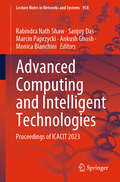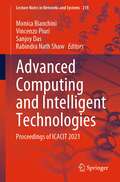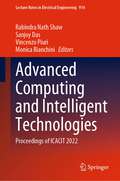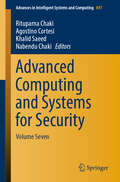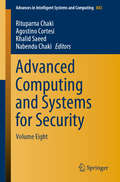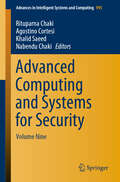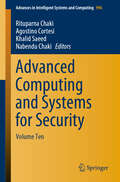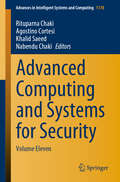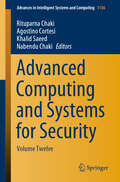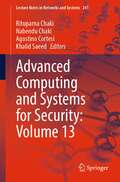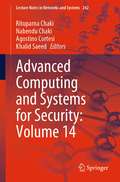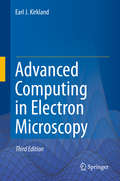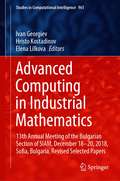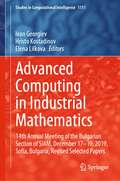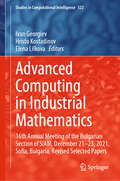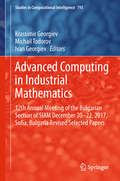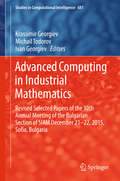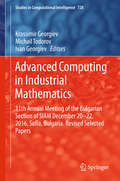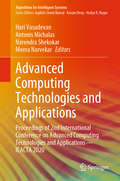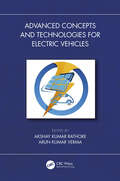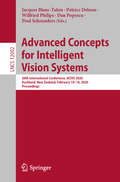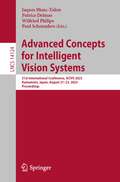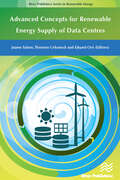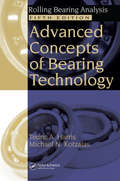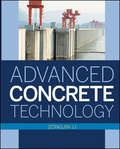- Table View
- List View
Advanced Computing and Intelligent Technologies: Proceedings of ICACIT 2023 (Lecture Notes in Networks and Systems #958)
by Marcin Paprzycki Monica Bianchini Ankush Ghosh Rabindra Nath Shaw Sanjoy DasThis book gathers selected high-quality research papers presented at International Conference on Advanced Computing and Intelligent Technologies (ICACIT 2023), which is organized by Indira Gandhi National Tribal University, Regional Campus Manipur (IGNTU-RCM), during December 8–9, 2023. It discusses emerging topics pertaining to advanced computing, intelligent technologies and networks including AI and machine learning, data mining, big data analytics, high-performance computing network performance analysis, Internet of things networks, wireless sensor networks, and others. The book offers an asset for researchers from both academia and industries involved in advanced studies.
Advanced Computing and Intelligent Technologies: Proceedings of ICACIT 2021 (Lecture Notes in Networks and Systems #218)
by Vincenzo Piuri Monica Bianchini Rabindra Nath Shaw Sanjoy DasThis book gathers selected high-quality research papers presented at International Conference on Advanced Computing and Intelligent Technologies (ICACIT 2021) held at NCR New Delhi, India, during March 20–21, 2021, jointly organized by Galgotias University, India, and Department of Information Engineering and Mathematics Università Di Siena, Italy. It discusses emerging topics pertaining to advanced computing, intelligent technologies, and networks including AI and machine learning, data mining, big data analytics, high-performance computing network performance analysis, Internet of things networks, wireless sensor networks, and others. The book offers a valuable asset for researchers from both academia and industries involved in advanced studies.
Advanced Computing and Intelligent Technologies: Proceedings of ICACIT 2022 (Lecture Notes in Electrical Engineering #914)
by Rabindra Nath Shaw Sanjoy Das Vincenzo Piuri Monica BianchiniThis book gathers selected high-quality research papers presented at International Conference on Advanced Computing and Intelligent Technologies (ICACIT 2022), held at BIHER Chennai India, during March 12–13, 2022, jointly organized by Institute of Higher Education and Research Chennai 600073, Indira Gandhi National Tribal University, Regional Campus Manipur, India, and Department of Information Engineering and Mathematics Università Di Siena, Italy. It discusses emerging topics pertaining to advanced computing, intelligent technologies and networks including AI and machine learning, data mining, big data analytics, high performance computing network performance analysis, Internet of things networks, wireless sensor networks, and others. The book offers a valuable asset for researchers from both academia and industries involved in advanced studies.
Advanced Computing and Systems for Security: Volume Seven (Advances in Intelligent Systems and Computing #897)
by Rituparna Chaki Agostino Cortesi Khalid Saeed Nabendu ChakiThe book includes extended versions of selected papers discussed and presented at the 5th International Doctoral Symposium on Applied Computation and Security Systems (ACSS 2018) held in Kolkata, India on February 9–11, 2018. The symposium was organized by the University of Calcutta’s Department of Computer Science & Engineering and A. K. Choudhury School of Information Technology, and the International partners were Ca Foscari University of Venice, Italy and Bialystok University of Technology, Poland. Reflect the symposium’s sessions, the book discusses topics such as biometrics, image processing, pattern recognition, algorithms, cloud computing, wireless sensor networks and security systems.
Advanced Computing and Systems for Security: Volume Eight (Advances in Intelligent Systems and Computing #883)
by Rituparna Chaki Agostino Cortesi Khalid Saeed Nabendu ChakiThe book includes extended versions of selected papers discussed and presented at the 5th International Doctoral Symposium on Applied Computation and Security Systems (ACSS 2018) held in Kolkata, India on February 9–11, 2018. The symposium was organized by the University of Calcutta’s Department of Computer Science & Engineering and A. K. Choudhury School of Information Technology, and the International partners were Ca Foscari University of Venice, Italy and Bialystok University of Technology, Poland. Reflect the symposium’s sessions, the book discusses topics such as biometrics, image processing, pattern recognition, algorithms, cloud computing, wireless sensor networks and security systems.
Advanced Computing and Systems for Security: Volume Nine (Advances in Intelligent Systems and Computing #995)
by Rituparna Chaki Agostino Cortesi Khalid Saeed Nabendu ChakiThis book features extended versions of selected papers that were presented and discussed at the 6th International Doctoral Symposium on Applied Computation and Security Systems (ACSS 2019) held in Kolkata, India on 12–13 March, 2019. Organized by the Departments of Computer Science & Engineering and A. K. Choudhury School of Information Technology, both from the University of Calcutta, the symposium’s international partners were Ca' Foscari University of Venice, Italy and Bialystok University of Technology, Poland. The chapters cover topics such as biometrics, image processing, pattern recognition, algorithms, cloud computing, wireless sensor networks and security systems, reflecting the various symposium sessions.
Advanced Computing and Systems for Security: Volume Ten (Advances in Intelligent Systems and Computing #996)
by Rituparna Chaki Agostino Cortesi Khalid Saeed Nabendu ChakiThis book features extended versions of selected papers that were presented and discussed at the 6th International Doctoral Symposium on Applied Computation and Security Systems (ACSS 2019) held in Kolkata, India on 12–13 March, 2019. Organized by the Departments of Computer Science & Engineering and A.K. Choudhury School of Information Technology, both from the University of Calcutta, the symposium’s international partners were Ca' Foscari University of Venice, Italy and Bialystok University of Technology, Poland. The chapters cover topics such as biometrics, image processing, pattern recognition, algorithms, cloud computing, wireless sensor networks and security systems, reflecting the various symposium sessions.
Advanced Computing and Systems for Security: Volume Eleven (Advances in Intelligent Systems and Computing #1178)
by Rituparna Chaki Agostino Cortesi Khalid Saeed Nabendu ChakiThis book features extended versions of selected papers that were presented and discussed at the 7th International Doctoral Symposium on Applied Computation and Security Systems (ACSS 2020) held in Kolkata, India on February 28–29, 2020. Organized by the Departments of Computer Science & Engineering and A. K. Choudhury School of Information Technology, both from the University of Calcutta, the symposium’s international partners were Ca Foscari University of Venice, Italy and Bialystok University of Technology, Poland. The chapters cover topics such as biometrics, image processing, pattern recognition, algorithms, cloud computing, wireless sensor networks and security systems, reflecting the various symposium sessions.
Advanced Computing and Systems for Security: Volume Twelve (Advances in Intelligent Systems and Computing #1136)
by Khalid Saeed Nabendu Chaki Agostino Cortesi Rituparna ChakiThis book features extended versions of selected papers that were presented and discussed at the 7th International Doctoral Symposium on Applied Computation and Security Systems (ACSS 2020), held in Kolkata, India, on February 28–29, 2020. Organized by the Departments of Computer Science & Engineering and A. K. Choudhury School of Information Technology at the University of Calcutta, the symposium’s international partners were Ca' Foscari University of Venice, Italy, and Bialystok University of Technology, Poland. The topics covered include biometrics, image processing, pattern recognition, algorithms, cloud computing, wireless sensor networks, and security systems, reflecting the various symposium sessions.
Advanced Computing and Systems for Security: Volume 13 (Lecture Notes in Networks and Systems #241)
by Rituparna Chaki Nabendu Chaki Agostino Cortesi Khalid SaeedThis book features extended versions of selected papers that were presented and discussed at the 8th International Doctoral Symposium on Applied Computation and Security Systems (ACSS 2021), held in Kolkata, India, on April 9–10, 2021. Organized by the Departments of Computer Science & Engineering and A. K. Choudhury School of Information Technology at the University of Calcutta, the symposium’s international partners were Ca' Foscari University of Venice, Italy, and Bialystok University of Technology, Poland. The topics covered include biometrics, image processing, pattern recognition, algorithms, cloud computing, wireless sensor networks, and security systems, reflecting the various symposium sessions.
Advanced Computing and Systems for Security: Volume 14 (Lecture Notes in Networks and Systems #242)
by Rituparna Chaki Nabendu Chaki Agostino Cortesi Khalid SaeedThis book features extended versions of selected papers that were presented and discussed at the 8th International Doctoral Symposium on Applied Computation and Security Systems (ACSS 2021), held in Kolkata, India, on April 9–10, 2021. Organized by the Departments of Computer Science & Engineering and A. K. Choudhury School of Information Technology at the University of Calcutta, the symposium’s international partners were Ca' Foscari University of Venice, Italy, and Bialystok University of Technology, Poland. The topics covered include biometrics, image processing, pattern recognition, algorithms, cloud computing, wireless sensor networks, and security systems, reflecting the various symposium sessions.
Advanced Computing in Electron Microscopy
by Earl J. KirklandThis updated and revised edition of a classic work provides a summary of methods for numerical computation of high resolution conventional and scanning transmission electron microscope images. At the limits of resolution, image artifacts due to the instrument and the specimen interaction can complicate image interpretation. Image calculations can help the user to interpret and understand high resolution information in recorded electron micrographs. The book contains expanded sections on aberration correction, including a detailed discussion of higher order (multipole) aberrations and their effect on high resolution imaging, new imaging modes such as ABF (annular bright field), and the latest developments in parallel processing using GPUs (graphic processing units), as well as updated references. Beginning and experienced users at the advanced undergraduate or graduate level will find the book to be a unique and essential guide to the theory and methods of computation in electron microscopy.
Advanced Computing in Industrial Mathematics: 13th Annual Meeting of the Bulgarian Section of SIAM, December 18-20, 2018, Sofia, Bulgaria, Revised Selected Papers (Studies in Computational Intelligence #961)
by Ivan Georgiev Hristo Kostadinov Elena LilkovaThis book gathers the peer-reviewed proceedings of the 13th Annual Meeting of the Bulgarian Section of the Society for Industrial and Applied Mathematics, BGSIAM'18, held in Sofia, Bulgaria. The general theme of BGSIAM'18 was industrial and applied mathematics with particular focus on: mathematical physics, numerical analysis, high performance computing, optimization and control, mathematical biology, stochastic modeling, machine learning, digitization and imaging, advanced computing in environmental, biomedical and engineering applications.
Advanced Computing in Industrial Mathematics: 14th Annual Meeting of the Bulgarian Section of SIAM, December 17-19, 2019, Sofia, Bulgaria, Revised Selected Papers (Studies in Computational Intelligence #1111)
by Ivan Georgiev Hristo Kostadinov Elena LilkovaThis book gathers the peer-reviewed proceedings of the 14th Annual Meeting of the Bulgarian Section of the Society for Industrial and Applied Mathematics, BGSIAM'19, held in Sofia, Bulgaria. The general theme of BGSIAM'19 was industrial and applied mathematics with particular focus on mathematical physics, numerical analysis, high-performance computing, optimization and control, mathematical biology, stochastic modeling, machine learning, digitization and imaging, and advanced computing in environmental, biomedical, and engineering applications.
Advanced Computing in Industrial Mathematics: 16th Annual Meeting of the Bulgarian Section of SIAM, December 21–23, 2021, Sofia, Bulgaria, Revised Selected Papers (Studies in Computational Intelligence #522)
by Ivan Georgiev Hristo Kostadinov Elena LilkovaThis book gathers the peer-reviewed proceedings of the 16th Annual Meeting of the Bulgarian Section of the Society for Industrial and Applied Mathematics, BGSIAM'21, held in Sofia, Bulgaria. The general theme of BGSIAM'21 was industrial and applied mathematics with particular focus on: mathematical physics, numerical analysis, high performance computing, optimization and control, mathematical biology, stochastic modeling, machine learning, digitization and imaging, advanced computing in environmental, biomedical and engineering applications.
Advanced Computing in Industrial Mathematics: 11th Annual Meeting Of The Bulgarian Section Of Siam December 20-22, 2016, Sofia, Bulgaria. Revised Selected Papers (Studies in Computational Intelligence #728)
by Ivan Georgiev Michail Todorov Krassimir GeorgievThis book gathers the peer-reviewed proceedings of the 12th Annual Meeting of the Bulgarian Section of the Society for Industrial and Applied Mathematics, BGSIAM’17, held in Sofia, Bulgaria, in December 2017. The general theme of BGSIAM’17 was industrial and applied mathematics, with a particular focus on: high-performance computing, numerical methods and algorithms, analysis of partial differential equations and their applications, mathematical biology, control and uncertain systems, stochastic models, molecular dynamics, neural networks, genetic algorithms, metaheuristics for optimization problems, generalized nets, and Big Data.
Advanced Computing in Industrial Mathematics: Revised Selected Papers of the 10th Annual Meeting of the Bulgarian Section of SIAM December 21-22, 2015, Sofia, Bulgaria (Studies in Computational Intelligence #681)
by Krassimir Georgiev Michail Todorov Ivan GeorgievThis book presents recent research on Advanced Computing in Industrial Mathematics, which is one of the most prominent interdisciplinary areas and combines mathematics, computer science, scientific computations, engineering, physics, chemistry, medicine, etc. Further, the book presents the tools of Industrial Mathematics, which are based on mathematical models, and the corresponding computer codes, which are used to perform virtual experiments to obtain new data or to better understand the existing experimental results. The book gathers the peer-reviewed papers presented during the 10th Annual Meeting of the Bulgarian Section of SIAM (BGSIAM) from December 21 to 22, 2015 in Sofia, Bulgaria.
Advanced Computing in Industrial Mathematics: 11th Annual Meeting of the Bulgarian Section of SIAM December 20-22, 2016, Sofia, Bulgaria. Revised Selected Papers (Studies in Computational Intelligence #728)
by Krassimir Georgiev Michail Todorov Ivan GeorgievThis book presents recent research on Advanced Computing in Industrial Mathematics, which is one of the most prominent interdisciplinary areas and combines mathematics, computer science, scientific computations, engineering, physics, chemistry, medicine, etc. Further, the book presents the tools of Industrial Mathematics, which are based on mathematical models, and the corresponding computer codes, which are used to perform virtual experiments to obtain new data or to better understand the existing experimental results. The book gathers the peer-reviewed papers presented during the 10th Annual Meeting of the Bulgarian Section of SIAM (BGSIAM) from December 21 to 22, 2015 in Sofia, Bulgaria.
Advanced Computing Technologies and Applications: Proceedings of 2nd International Conference on Advanced Computing Technologies and Applications—ICACTA 2020 (Algorithms for Intelligent Systems)
by Hari Vasudevan Antonis Michalas Narendra Shekokar Meera NarvekarThis book features selected papers presented at the 2nd International Conference on Advanced Computing Technologies and Applications, held at SVKM’s Dwarkadas J. Sanghvi College of Engineering, Mumbai, India, from 28 to 29 February 2020. Covering recent advances in next-generation computing, the book focuses on recent developments in intelligent computing, such as linguistic computing, statistical computing, data computing and ambient applications.
Advanced Concepts and Technologies for Electric Vehicles
by Akshay Kumar Rathore Arun Kumar VermaThis book explains the basic and advanced technology behind the Power Electronics Converters for EV charging, and their significant developments, and introduces the Grid Impact issues that underpin the grid integration of electric vehicles. Advanced Concepts and Technologies for Electric Vehicles reviews state-of-the-art and new configurations and concepts of more electric vehicles and EV charging, mitigating the impact of EV charging on the power grid, and technical considerations of EV charging infrastructures. The book considers the environmental benefits and advantages of electric vehicles and their component devices. It includes case studies of different power electronic converters used for charging EVs. It offers a review of PFC-based AC chargers, WBG-based chargers, and Wireless chargers. The authors also explore multistage charging systems and their possible implementations. The book also examines the challenges and opportunities posed by the progressive integration of electric drive vehicles on the power grid and reported solutions for their mitigation. The book is intended for professionals, researchers, and engineers in the electric vehicle industry as well as advanced students in electrical engineering who benefit from this comprehensive coverage of electric vehicle technology. Readers can get an in-depth insight into the technology deployment in EV transportation and utilize that knowledge to develop novel ideas in the EV area.
Advanced Concepts for Intelligent Vision Systems: 20th International Conference, ACIVS 2020, Auckland, New Zealand, February 10–14, 2020, Proceedings (Lecture Notes in Computer Science #12002)
by Jacques Blanc-Talon Patrice Delmas Wilfried Philips Dan Popescu Paul ScheundersThis book constitutes the proceedings of the 20th INternational Conference on Advanced Concepts for Intelligent Vision Systems, ACIVS 2020, held in Auckland, New Zealand, in February 2020. The 48 papers presented in this volume were carefully reviewed and selected from a total of 78 submissions. They were organized in topical sections named: deep learning; biomedical image analysis; biometrics and identification; image analysis; image restauration, compression and watermarking; tracking, and mapping and scene analysis.
Advanced Concepts for Intelligent Vision Systems: 21st International Conference, ACIVS 2023 Kumamoto, Japan, August 21–23, 2023 Proceedings (Lecture Notes in Computer Science #14124)
by Jaques Blanc-Talon Patrice Delmas Wilfried Philips Paul ScheundersThis book constitutes the proceedings of the 21st International Conference on Advanced Concepts for Intelligent Vision Systems, ACIVS 2023, held in Kumamoto, Japan, during August 2023. The 31 papers presented in this volume were carefully reviewed and selected from a total of 48 submissions. They were organized in topical sections named: Computer Vision, Affective Computing and Human Interactions, Managing the Biodiversity, Robotics and Drones, Machine Learning.
Advanced Concepts for Renewable Energy Supply of Data Centres
by Jaume Salom Thorsten Urbaneck Eduard OróThe rapid increase of cloud computing, high performance computing (HPC) and the vast growth in Internet and Social Media use have aroused the interest in energy consumption and the carbon footprint of Data Centres. Data Centres primarily contain electronic equipment used for data processing (servers), data storage (storage equipment), and communications (network equipment). Collectively, this equipment processes, stores, and transmits digital information and is known as information technology (IT) equipment. Advanced Concepts for Renewable Energy Supply of Data Centres introduces a number of technical solutions for the supply of power and cooling energy into Data Centres with enhanced utilisation of renewable energy sources in order to achieve low energy Data Centres. Because of the high energy density nature of these unique infrastructures, it is essential to implement energy efficiency measures and reduce consumption before introducing any renewable energy source. A holistic approach is used with the objective of integrating many technical solutions such as management of the IT (Information Technology) load, efficient electrical supply to the IT systems, Low-Ex air-conditioning systems, interaction with district heating and cooling networks, re-use of heat, free cooling (air, seawater, groundwater), optimal use of heat and cold storage, electrical storage and integration in smart grids. This book is therefore a catalogue of advanced technical concepts that could be integrated into Data Centres portfolio in order to increase the overall efficiency and the share of renewable energies in power and cooling supply. Based on dynamic energy models implemented in TRNSYS some concepts are deeply evaluated through yearly simulations. The results of the simulation are illustrated with Sankey charts, where the energy flows per year within the subsystems of each concept for a selected scenario are shown, and graphs showing the results of parametric analysis. A set of environmental metrics (as the non-renewable primary energy) and financial metrics (CAPEX and OPEX) as well of energy efficiency metrics like the well-known PUE, are described and used to evaluate the different technical concepts.
Advanced Concepts of Bearing Technology: Rolling Bearing Analysis, Fifth Edition
by Tedric A. Harris Michael N. KotzalasFor the last four decades, Tedric Harris' Rolling Bearing Analysis has been the "bible" for engineers involved in rolling bearing technology. Why do so many students and practicing engineers rely on this book? The answer is simple: because of its complete coverage from low- to high-speed applications and full derivations of the underlying mathemati
Advanced Concrete Technology
by Zongjin LiOver the past two decades concrete has enjoyed a renewed level of research and testing, resulting in the development of many new types of concrete. Through the use of various additives, production techniques and chemical processes, there is now a great degree of control over the properties of specific concretes for a wide range of applications. New theories, models and testing techniques have also been developed to push the envelope of concrete as a building material. There is no current textbook which brings all of these advancements together in a single volume. This book aims to bridge the gap between the traditional concrete technologies and the emerging state-of-the-art technologies which are gaining wider use.
